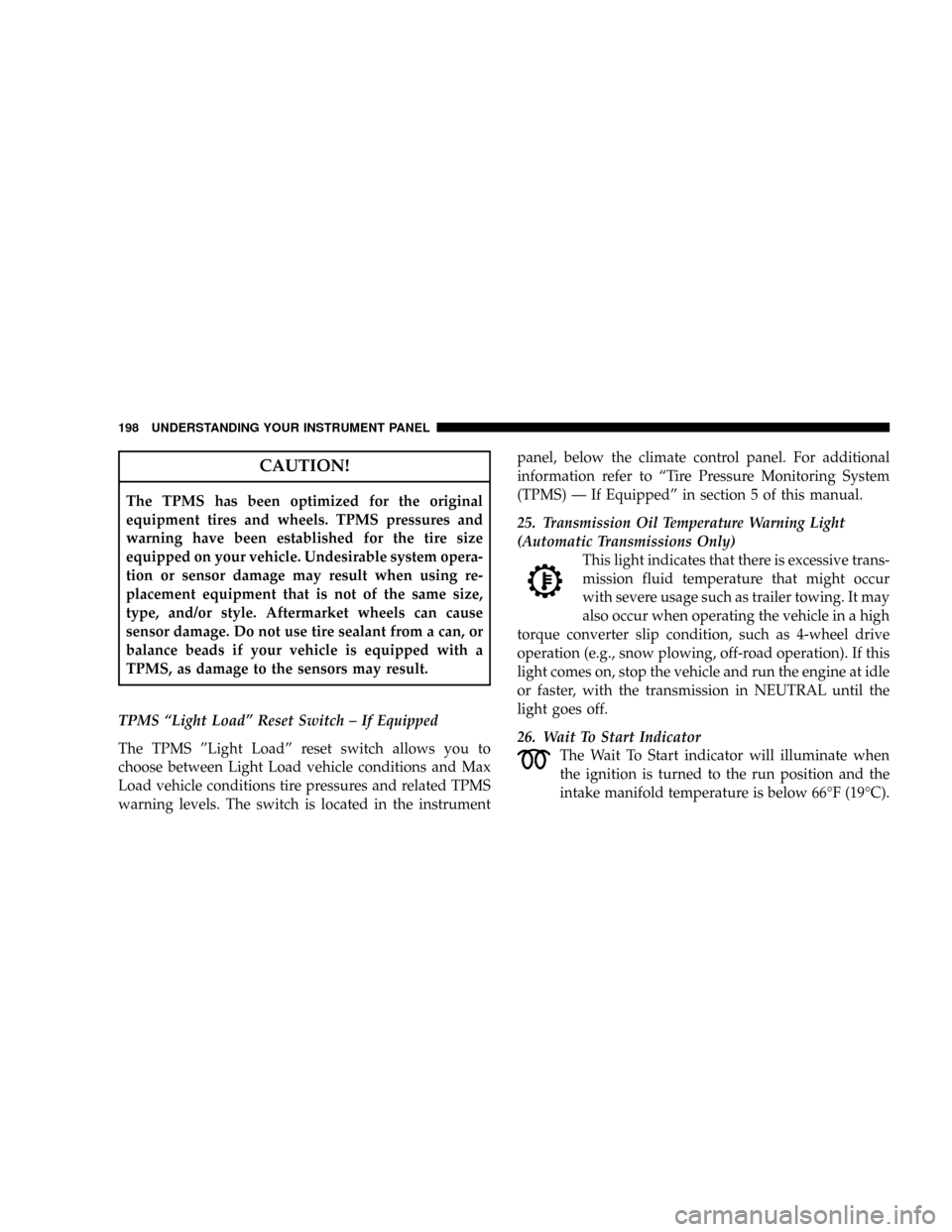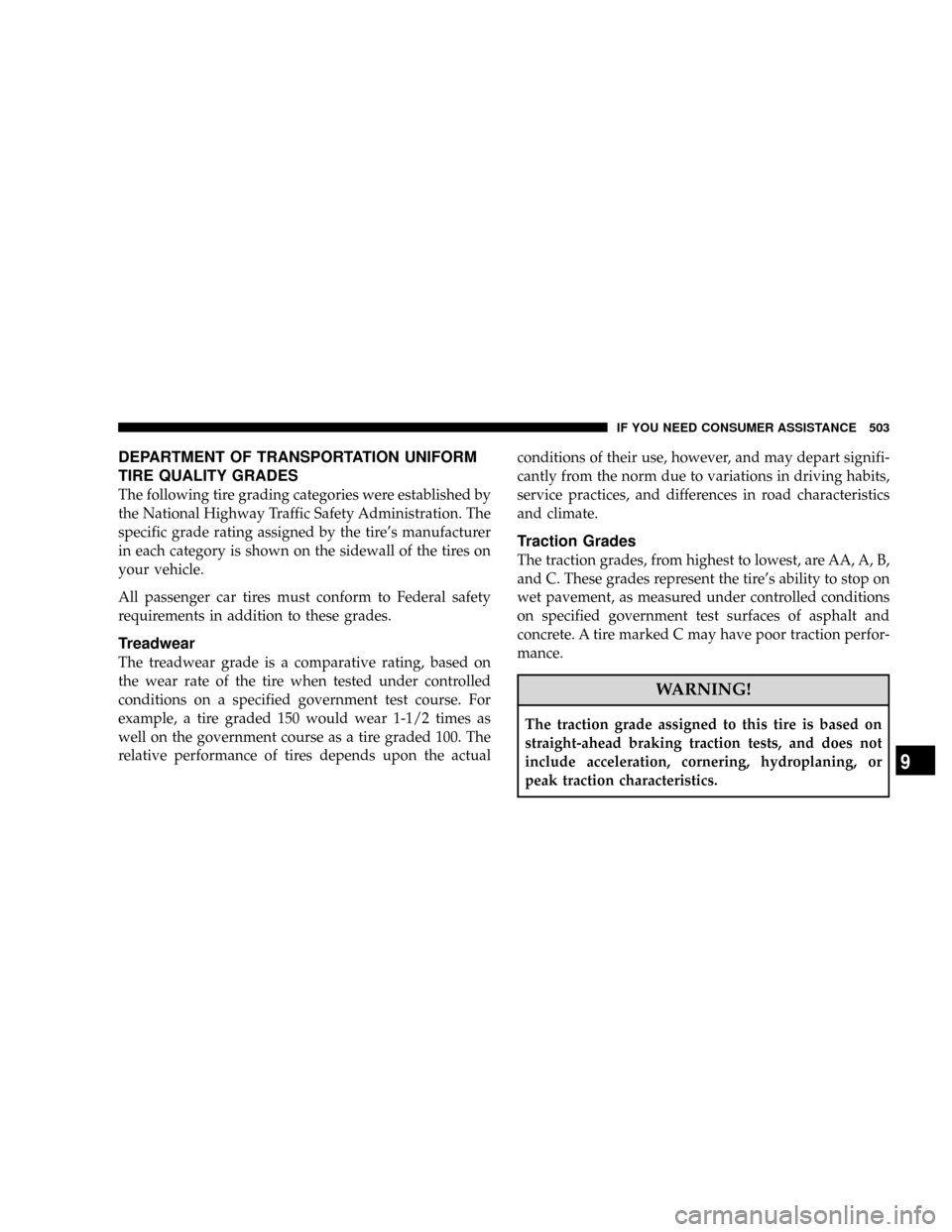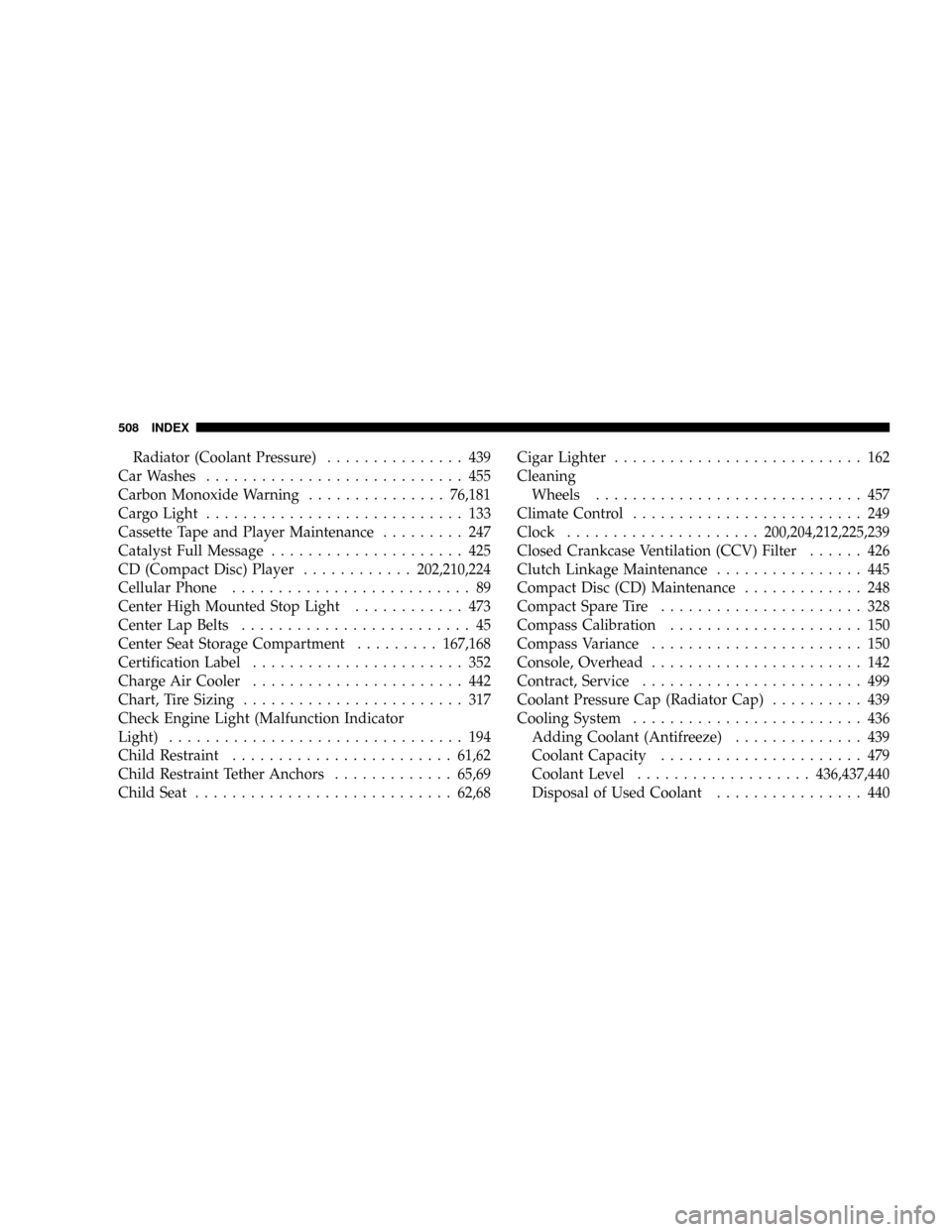Page 189 of 527
INSTRUMENTS AND CONTROLS
1 Ð Headlight Switch 6 Ð Passenger Airbag* 11 Ð TPMS ªLight Loadº Reset Switch* 16 Ð Transfer Case Control Switch*
2 Ð Air Outlets 7 Ð Glove Box 12 Ð Power Sliding Back Glass Switch* 17 Ð Parking Brake Release Lever
3 Ð Instrument Cluster 8 Ð Passenger Airbag On/Off Switch* 13 Ð Cupholders 18 Ð Adjustable Pedal Control Switch*
4 Ð Climate Controls 9 Ð Power Outlet 14 Ð Exhaust Brake Switch* * If Equipped
5 Ð Radio 10 Ð Heated Seat Switch 15 Ð Cigar Lighter
UNDERSTANDING YOUR INSTRUMENT PANEL 187
4
Page 200 of 527

CAUTION!
The TPMS has been optimized for the original
equipment tires and wheels. TPMS pressures and
warning have been established for the tire size
equipped on your vehicle. Undesirable system opera-
tion or sensor damage may result when using re-
placement equipment that is not of the same size,
type, and/or style. Aftermarket wheels can cause
sensor damage. Do not use tire sealant from a can, or
balance beads if your vehicle is equipped with a
TPMS, as damage to the sensors may result.
TPMS ªLight Loadº Reset Switch ± If Equipped
The TPMS ºLight Loadº reset switch allows you to
choose between Light Load vehicle conditions and Max
Load vehicle conditions tire pressures and related TPMS
warning levels. The switch is located in the instrumentpanel, below the climate control panel. For additional
information refer to ªTire Pressure Monitoring System
(TPMS) Ð If Equippedº in section 5 of this manual.
25. Transmission Oil Temperature Warning Light
(Automatic Transmissions Only)
This light indicates that there is excessive trans-
mission fluid temperature that might occur
with severe usage such as trailer towing. It may
also occur when operating the vehicle in a high
torque converter slip condition, such as 4-wheel drive
operation (e.g., snow plowing, off-road operation). If this
light comes on, stop the vehicle and run the engine at idle
or faster, with the transmission in NEUTRAL until the
light goes off.
26. Wait To Start Indicator
The Wait To Start indicator will illuminate when
the ignition is turned to the run position and the
intake manifold temperature is below 66ÉF (19ÉC).
198 UNDERSTANDING YOUR INSTRUMENT PANEL
Page 251 of 527
NOTE:If you experience difficulty in playing a particu-
lar disc, it may be damaged, oversized, or have theft
protection encoding. Try a known good disc before
considering disc player service.
RADIO OPERATION AND CELLULAR PHONES
Under certain conditions, the operation of a cellular
phone in your vehicle can cause erratic or noisy perfor-
mance from your radio. This condition may be lessened
or eliminated by relocating the cellular phone antenna.
This condition is not harmful to the radio. If your radio
performance does not satisfactorily ªclearº by the repo-
sitioning of the antenna, it is recommended that the radio
volume be turned down or off during cellular phone
operation.
CLIMATE CONTROLS
The controls for the heating and ventilation system in this
vehicle consist of a series of rotary knobs. These comfort
controls can be set to obtain desired interior conditions.
Climate Control Location
UNDERSTANDING YOUR INSTRUMENT PANEL 249
4
Page 505 of 527

DEPARTMENT OF TRANSPORTATION UNIFORM
TIRE QUALITY GRADES
The following tire grading categories were established by
the National Highway Traffic Safety Administration. The
specific grade rating assigned by the tire's manufacturer
in each category is shown on the sidewall of the tires on
your vehicle.
All passenger car tires must conform to Federal safety
requirements in addition to these grades.
Treadwear
The treadwear grade is a comparative rating, based on
the wear rate of the tire when tested under controlled
conditions on a specified government test course. For
example, a tire graded 150 would wear 1-1/2 times as
well on the government course as a tire graded 100. The
relative performance of tires depends upon the actualconditions of their use, however, and may depart signifi-
cantly from the norm due to variations in driving habits,
service practices, and differences in road characteristics
and climate.
Traction Grades
The traction grades, from highest to lowest, are AA, A, B,
and C. These grades represent the tire's ability to stop on
wet pavement, as measured under controlled conditions
on specified government test surfaces of asphalt and
concrete. A tire marked C may have poor traction perfor-
mance.
WARNING!
The traction grade assigned to this tire is based on
straight-ahead braking traction tests, and does not
include acceleration, cornering, hydroplaning, or
peak traction characteristics.
IF YOU NEED CONSUMER ASSISTANCE 503
9
Page 510 of 527

Radiator (Coolant Pressure)............... 439
Car Washes............................ 455
Carbon Monoxide Warning...............76,181
Cargo Light............................ 133
Cassette Tape and Player Maintenance......... 247
Catalyst Full Message..................... 425
CD (Compact Disc) Player............202,210,224
Cellular Phone.......................... 89
Center High Mounted Stop Light............ 473
Center Lap Belts......................... 45
Center Seat Storage Compartment.........167,168
Certification Label....................... 352
Charge Air Cooler....................... 442
Chart, Tire Sizing........................ 317
Check Engine Light (Malfunction Indicator
Light)................................ 194
Child Restraint........................61,62
Child Restraint Tether Anchors.............65,69
Child Seat............................62,68Cigar Lighter........................... 162
Cleaning
Wheels............................. 457
Climate Control......................... 249
Clock.....................200,204,212,225,239
Closed Crankcase Ventilation (CCV) Filter...... 426
Clutch Linkage Maintenance................ 445
Compact Disc (CD) Maintenance............. 248
Compact Spare Tire...................... 328
Compass Calibration..................... 150
Compass Variance....................... 150
Console, Overhead....................... 142
Contract, Service........................ 499
Coolant Pressure Cap (Radiator Cap).......... 439
Cooling System......................... 436
Adding Coolant (Antifreeze).............. 439
Coolant Capacity...................... 479
Coolant Level...................436,437,440
Disposal of Used Coolant................ 440
508 INDEX